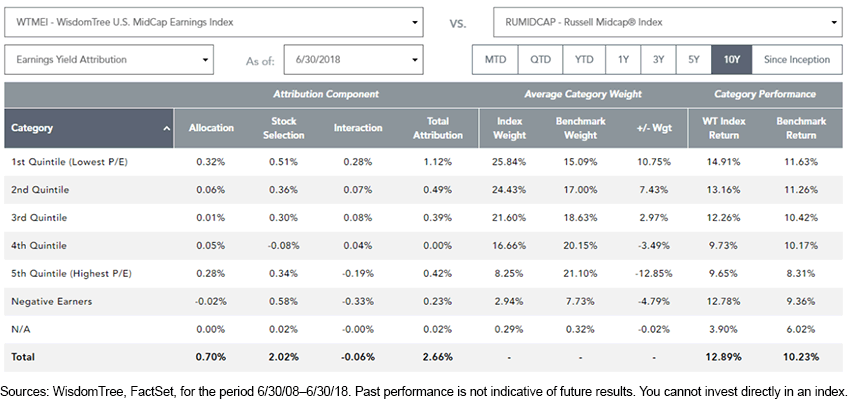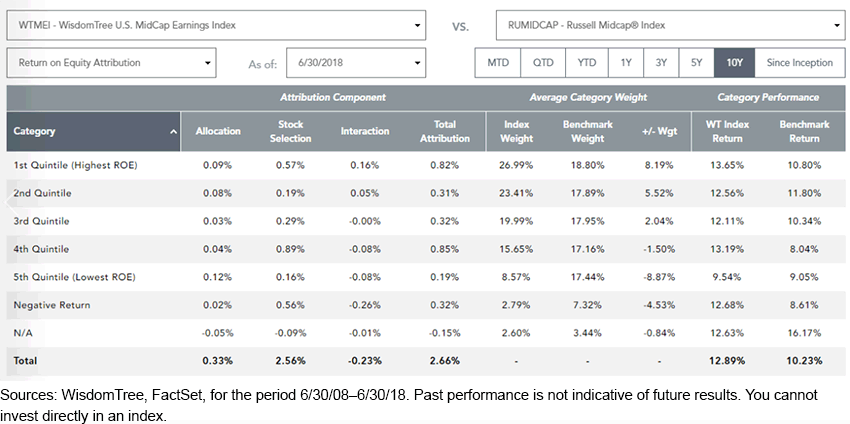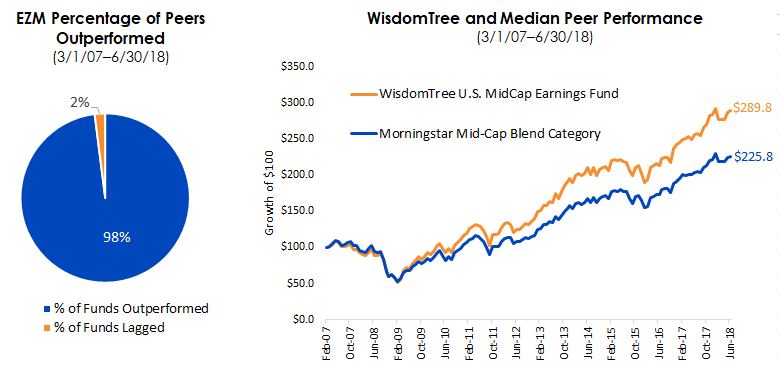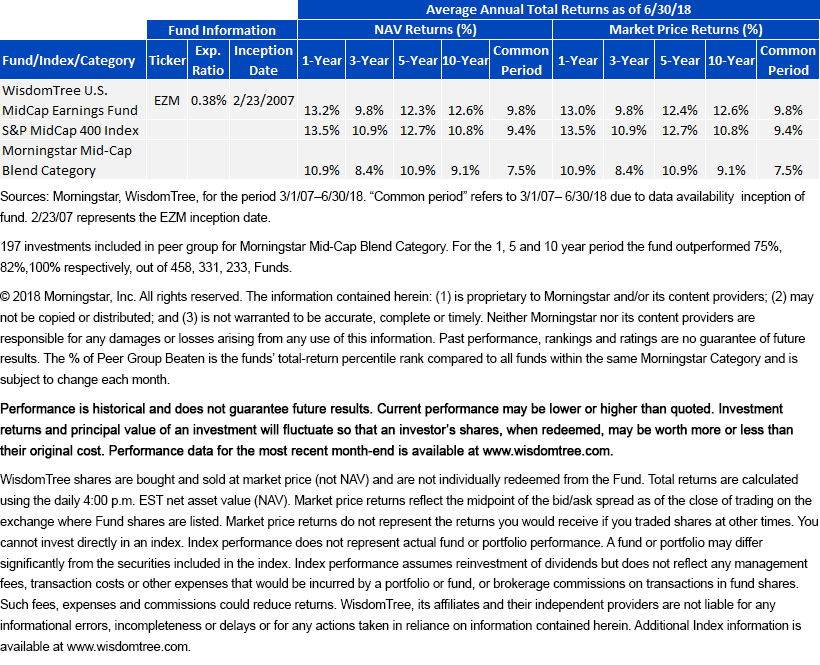Why Value Investors Don’t Have to Wait for Mean Reversion


When will value turn around and outperform growth? Over the past several years, this arguably has been one of the most hotly debated questions in index investing. Investors are now undoubtedly familiar with some sort of graph that shows the outperformance that growth has experienced over the past 10 years, punctuating the question around value mean reversion.
With live performance available for many of WisdomTree’s Funds for the past 10 years, some investors may be surprised to see outperformance, particularly in the small- and mid-cap segment, from some of our most value-tilted strategies. In this blog post, we utilize our Index Performance Attribution tool to explain the key drivers of outperformance of our mid-cap earnings Index over the past 10 years.
Quantifying Value: Earnings Yield Attribution
The tendency for inexpensive companies, using a ratio such as price-to-earnings (P/E), to outperform expensive companies over longer periods of time is one of the more generally accepted principles in factor investing. Research such as this contributed to the creation of WisdomTree’s earnings-weighted family that rebalances back to core earnings on an annual basis to reduce valuation risks. By segmenting the WisdomTree U.S. MidCap Earnings Index and the Russell Midcap Index into earnings yield quintiles, we can review how the least expensive stocks have performed relative to the more expensive stocks in real time, and how this helped contribute to 266 basis points (bps) of outperformance for the WisdomTree Index as of June 30, 2018:
- First Quintile (Lowest P/E): The WisdomTree Index had an active weight of 10.75% in this quintile, which was also the best performing in the benchmark quintile. This quintile was the biggest contributor to outperformance, adding 112 of the total 266 bps of outperformance.
- Fifth Quintile (Highest P/E): The WisdomTree Index was under-weight in the most expensive quintile by 12.85%, the largest absolute active weight of all the categories. This quintile was the worst performing in the benchmark, underperforming the Russell index’s total return by nearly 200 bps. By tilting away from these expensive stocks, the category contributed 42 bps of outperformance.

Quantifying Quality: ROE Attribution
Return on equity (ROE) is a key metric of profitability for equity investors, and one that is helpful to utilize in deconstructing the impact of our earnings-weighted methodology on returns. Similar to what was done for earnings yield quintiles, the two indexes are segmented into ROE quintiles, as well as a category for negative return.
- Top Two ROE Quintiles: Over short periods of time, we can see any of the commonly accepted factors go out of favor. One surprise of 2018 thus far has been how well negative earners have performed in the mid-cap segment. Negative earners have outpaced all other ROE quintiles in a junk-led rally, resulting in a headwind for the WisdomTree Index’s year-to-date returns. Over the 10-year period, the outperformance of the highest ROE quintiles has been definitive. The WisdomTree Index had a combined 14% over-weight in the top two quintiles, contributing 113 bps to outperformance.
- Negative Return Category: What we have consistently seen when dipping down in market cap size is this negative return weight becomes more prevalent for market cap-weighted indexes, creating a greater exposure to companies more at risk of bankruptcy due to a lack of profitability. The WisdomTree Index had roughly 2.8% weight in this bucket, with over twice this exposure for the Russell index, which had 7.3% allocated there. This was the second-worst-performing category for the benchmark, which contributed 32 bps to outperformance.

Don’t Sleep on Value
While one would expect an index that has outperformed its benchmark by 266 bps over 10 years should have stretched valuations, the design of WisdomTree’s Index instills a selling discipline to mitigate any such valuation risk—an important consideration for investors in this aging bull market. As of June 30, 2018, the valuation discount for the WisdomTree Index is about 30% on a trailing P/E basis, a discount that could portend even greater opportunity for outperformance going forward should value finally come back into favor.

WisdomTree U.S. MidCap Earnings Fund (EZM): Beating 98% of Its Peers since Inception
The Fund tracking the WisdomTree U.S. MidCap Earnings Index, EZM, has proven its competitiveness up against both passive and active managers, beating 98% of Morningstar Category peers based on total return since inception. The combination of value and quality exposures, which we have highlighted through the earnings yield and ROE attributions, has helped this Fund rise toward the top of its peer group despite the headwind of value over this period.
 '
'

All data as of June 30, 2018 and sourced from WisdomTree, FactSet.
Important Risks Related to this Article
There are risks associated with investing, including possible loss of principal. Funds focusing their investments on certain sectors and/or smaller companies increase their vulnerability to any single economic or regulatory development. This may result in greater share price volatility. Please read the Fund’s prospectus for specific details regarding the Fund’s risk profile.

